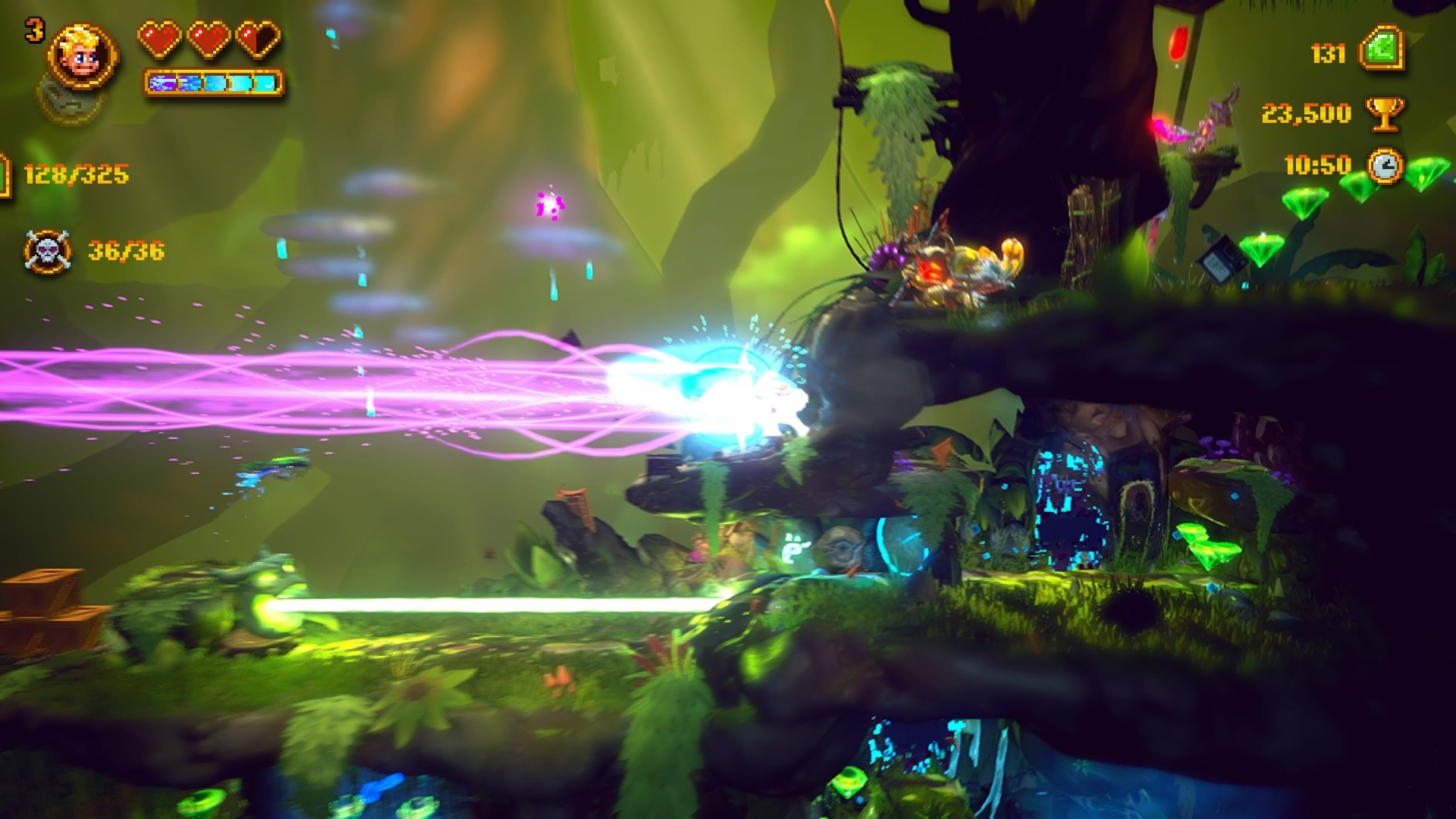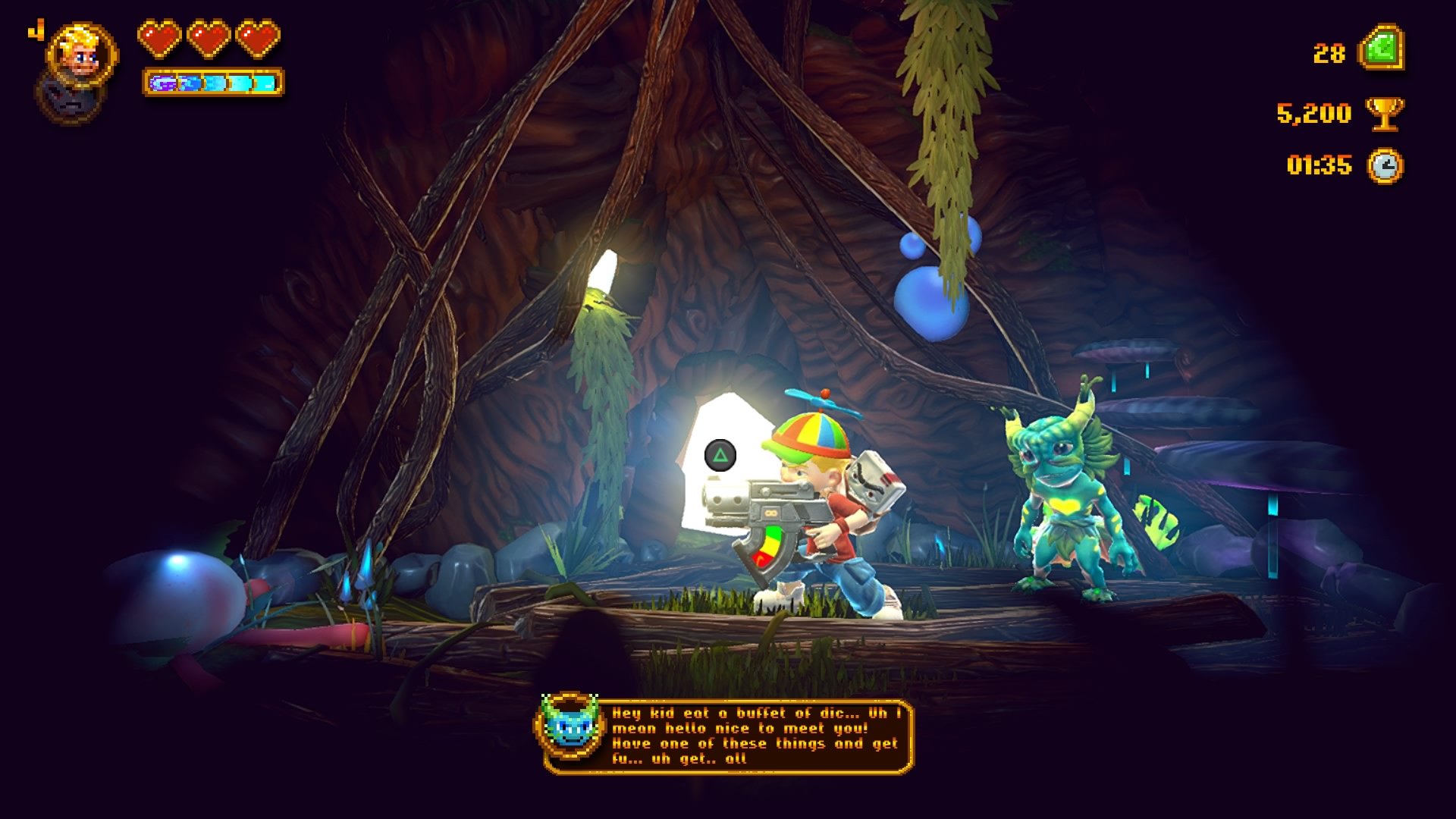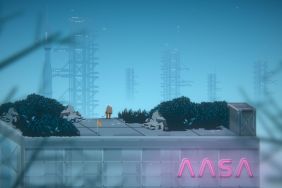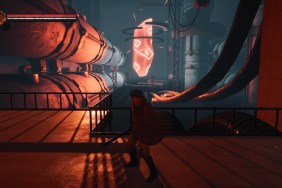
“Only 90s kids will remember…” No, this isn’t some nightmare-fueled Buzzfeed top 10 list, intent on stealing a few precious minutes of your life. This is an honest-to-goodness game review, targeted at a very specific gaming demographic: ME! Harkening back to an era that saw the 2D launch of such popular franchises as Commander Keen and Duke Nukem (yes, the same Duke Nukem that would later become a phenomenon in 3D) comes the neo-retro platformer Rad Rodgers. Composed of equal parts nostalgia and obscenity, this Kickstarter darling has finally made the jump from PC to consoles. Can its retro appeal and roguish charm also survive the transition?
Retro-tastic
If there was one thing that the PC platformers were lacking in the MS-DOS era, it was grit. There platformers-a-plenty during this formative period and most titles featured color saturations that could make even Lisa Frank wince. Rad Rodgers takes the design formula that was perfected by gangbuster publishers like Apogee, and then throws its aesthetic directly into the literal and figurative gutter. If you’ve ever wondered what it would be like if the Beans-with-Bacon Megarocket doubled as a meth lab, then I have the game for you.
Though the game would have you believe it stars an adorable kid with attitude, he is in fact playing a very distant second fiddle to Rodgers’ anthropomorphized video game console, Dusty. When the opening cutscene features Dusty dropping a rather forced dick joke, the tone becomes very apparent. Get used to sophomoric banter, because what the plot lacks in direction it makes up for in vulgarity. For better or worse, this is a game that puts the “F-U” back in “fun.”
In Rad Rodgers there isn’t really much direction provided aside from, “here’s a gun” and “go blast shit.” Most of the time this results in aimlessly running around expansive stages, feverishly hunting for missing puzzle pieces. Once all of the collectibles have been unearthed, they’re combined to open a door at the end of the stage. This is about as cookie cutter game design as you can get. Yet for some reason this startling familiarity took me back to late nights spent hunkered over my IBM PS/2, trying to capture all of the diamonds in Crystal Caves.
[imagebrowser id=6019]
Following a Formula
Most levels are fairly linear. Simply by following the tried and true logic of, “go towards where the baddies are coming from,” there are times that it damn near plays itself. Before long, the player is funneled in the relative vicinity of each puzzle piece, with very little necessity for deviation. Thankfully there are a few outliers to this formula. In those rare cases, the protagonist starts off a stage in the center of the map and needs to expand the puzzle hunt outwards in all directions. These exceptions, which highly emphasize exploration and experimentation, are where the design work really shines.
While traversing the world it become very evident that anything that moves on its own needs to be nuked back to the Stone Age. Trust me, this is not an exaggeration. If a creature is capable of any locomotion whatsoever, it’s a threat and must be murdered in the most fantastical manners possible. Machine guns, flamethrowers, rocket launchers, and even radioactive baseball bats make an appearance in Rodgers’ lethal arsenal.
The only exception to the whole “homicidal rampage” mandate are harmless residents that you will find inhabiting homes nestled into each level. Anticipating a home invasion, these characters are more than happy to turn over their valuables (and in at least one case, a used sex toy), in exchange for their lives. The only real question is whether the accosted civilians will turn over their valuables before or after colorfully telling Dusty where he can shove them.

Aside from his extremely vibrant and foul-mouthed commentary, Dusty actually does have a practical gameplay reason for existing. While exploring each stage there will occasionally be high-tech rifts that are playfully blamed on lazy programmers. The crude console dives into the game’s interpretation of the source code, in search of a solution to the obstruction. Many times these mini-games amount to nothing more than a maze or simple logic puzzle. In an interesting twist on the typical dynamic between Rodgers and Dusty, now the kid is in the position of mercilessly teasing the aging machine.
Despite feeling like the Rad Rodgers could’ve existed on a design document back in the 90s, it still makes fantastic use of current generation technologies. The visuals, art design, and even creative uses of lighting reflect the best parts of current releases. Yet in an interesting counterpoint, the level design and navigation are still firmly rooted an era that was lost to the sands of time. Now if only we could do something about the extremely off-color humor.
Who’s Laughing Now?
When speaking about the dialog earlier, I believe the term that I used was, “sophomoric.” In hindsight that may have been a bit generous. Targeting the same eighth grade sense of humor that made later incarnations of Duke Nukem notorious, the obscenity reached levels that were a bit much for even me. I am far from a prude, yet it seemed like many conversations were being gratuitous simply for the sake of being gratuitous. Early on, the over-the-top vileness was amusing in a lowest common denominator kind of way. However, it began to feel like the developers were stuck in an endless cycle of shock-value one-upmanship. If there were an actual narrative reason for the cutting linguistics, that would be one thing. Unfortunately, it feels like the experience could be just as entertaining sans filth.
One final curious matter revolves around the game’s actual name. Originally entitled, Rad Rodgers: World One on PC, the console iteration actually drops the whole “World One” surname. Despite the name change implying that the product may be more complete and feature far more content that its original incarnation, it only adds a couple of additional levels and bonus stages. The original name is far more appropriate because the campaign feels like a piece of what should’ve been a much more ambitious release. Ideally the developer will get the chance to explore this universe further, but in the meantime the end product is surprisingly brief and almost incomplete. Will we get to see more? Only time will tell.
It’s genuinely difficult to not be charmed by the foul-mouthed shenanigans of Rad Rodgers. The game somehow manages to morph extremely dated design ideals into a form that is palatable to the modern console crowd. If you can get past the constant barrage of unnecessary vulgarity, you will find the muted luster of something special hiding beneath. Here’s to hoping that Slipgate Studios gets the opprotunity to make something a bit more substantial the next time around.
Rad Rodgers review code provided by publisher. Version 1.0 reviewed on a standard PlayStation 4. For more information on scoring please see our Review Policy here.
-
Amazing art design and animations
-
It somehow manages to feel both old and new, simultaneously
-
Fun, lighthearted gameplay
-
Where's the narrative?
-
The humor sometimes goes a bit too far
-
Did he really try to give me a dirty butt plug?








